Looking for a trusted China faucet foundry and manufacturer? Chongqing SIPX Machinery, a professional faucet casting supplier, excels in precision investment casting for premium faucet components. Our skilled engineers employ state-of-the-art casting technology to manufacture durable faucet assemblies including bodies, handles, spouts, and internal mechanisms that comply with international quality standards. With over [X] years of specialized experience in faucet production, we provide comprehensive casting solutions with rigorous quality control at every stage. From stainless steel to bronze faucet parts, our China-based foundry guarantees superior dimensional accuracy, flawless surface finish, and reliable performance that surpass industry benchmarks. Partner with us for end-to-end faucet manufacturing service tailored to your specifications.
Examples of Faucet casting
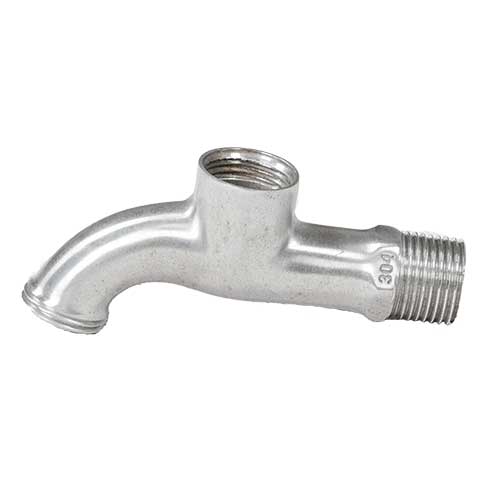
Faucet component casting
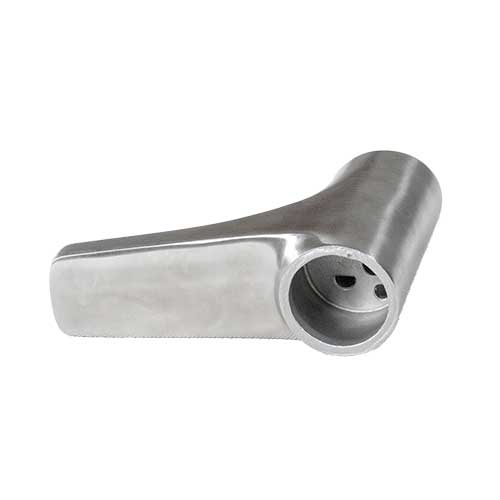
Casting faucet component
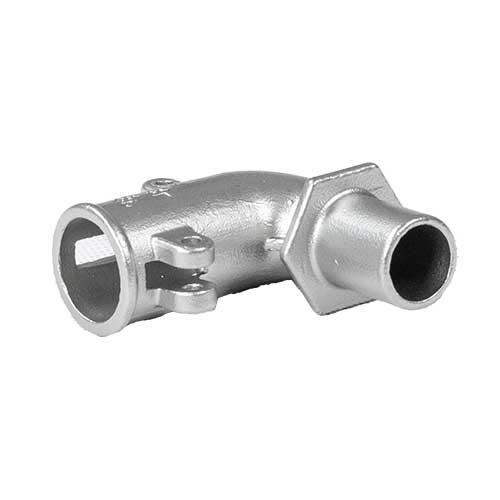
Stainless steel faucet component
Faucet foundry casting processes
Making a metal mold
Making a mold to make wax molds is the first step in faucet casting with investment casting method for a casting faucet foundry.
The ancient Chinese casting term “Mo Fan” holds special significance for modern faucet manufacturing. As a leading China faucet foundry, Chongqing SIPX Machinery traces its expertise back to these traditional bronze casting techniques. Originally, craftsmen used clay “Mo” (similar to today’s wax molds for faucet components) to create “Fan” molds (comparable to contemporary sand casting molds). They would carefully melt copper-tin alloys – the precursors to modern faucet materials – and pour the molten metal into these molds. Each “Fan” could produce only one unique faucet component, as both mold parts were destroyed after casting. This explains why early bronze faucet parts showed such distinctive variations.
Modern faucet casting technology has revolutionized these ancient methods. Today’s precision faucet manufacturing employs advanced 3D modeling and CNC machining centers to create durable aluminum molds – the contemporary equivalent of “Fan”. As an experienced faucet manufacturer and supplier, we utilize these technological advancements to produce consistent, high-quality faucet components. Aluminum’s excellent thermal conductivity and machinability make it ideal for faucet mold production, ensuring precise casting of faucet bodies, handles, and internal mechanisms. Depending on faucet complexity and order volume, our foundry offers both manual and automated mold solutions, continuing China’s rich casting legacy while meeting global faucet production standards.
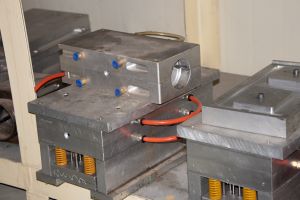
Manual Faucet mold
At Chongqing SIPX Machinery, our China-based faucet foundry specializes in both manual and automated mold processes for faucet manufacturing. This traditional manual mold method requires skilled workers to carefully close and demold each wax pattern. While the process involves multiple steps – including buckle operation, fixture adjustment, part removal, and precise placement – resulting in longer production times for each faucet wax mold, it remains invaluable for certain applications. As an experienced faucet manufacturer, we recommend this approach for small-batch orders or custom faucet components requiring extended lead times.
The advantages of manual mold technology make it particularly suitable for faucet production. First, the mold manufacturing cost is significantly lower compared to automated systems, making it ideal for prototype faucet parts or limited production runs. Second, this method excels at producing faucet components with complex geometries that might challenge other casting techniques. Finally, our foundry can manufacture relatively larger faucet parts using this process. The accompanying image showcases a premium investment casting faucet spare part mold from our facility, demonstrating the precision achievable through our manual casting service. As a reliable faucet supplier in China, we combine these traditional techniques with modern quality control to deliver exceptional results.
Making faucet wax patterns in Faucet Foundry
Making wax patterns is the second step of faucet casting in faucet foundry. Also called wax pressing or wax injection, it is the process of making wax molds through wax pressing machines and molds. The wax pressing machine injects was into the mold, and then takes out the wax pieces. The shape of the wax piece is the shape of the casting product after casting.
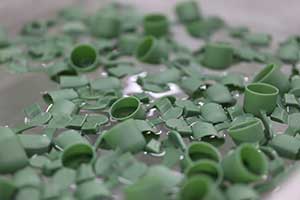
At first, we manually injected paraffin particles into the drop chamber under the wax press. However, this method is time-consuming and laborious, and it takes a long time to replenish wax. At the same time, the production cannot continue during replenishing wax. What’s more, the temperature drops due to the suspension of the wax pressing machine during replenishing wax, which will further lengthen the time to resume production. On the other hand, you will inevitably have a certain amount of impurities in the raw material of sodium granules, which will bring a great burden to the filter system for pressing garbage. Therefore, in order to solve these problems, we introduced an automatic wax injection system. A set of pre-treatment equipment for wax raw materials is set next to the wax injection workshop.
Making wax model patterns with manual mould in faucet foundry
Generally, the wax injection machine for making wax models with manual molds is different from the wax injection machine for making wax models with automatic molds. However, the principle and procedure of wax injection are basically the same.
If a faucet foundry wants to make wax patterns with manual molds, workers should first close the upper and lower parts of the molds, and then insert the locked bolts, pins, etc. in place. There are 4~6 simple mold bolts and pins, and for more complex molds, there can be up to a dozen bolts and pins. Workers need to spend more time locking. After the mold is assembled and locked, push it to the center of the wax injector workbench, and align the wax injection port of the mold with the nozzle of the wax injector. Then start the wax injection procedure and conduct wax mold injection production. At this time, the cooling table directly above the mold will press down to fix the mold, so that it will not move and play the role of cooling. The wax injection time varies with the size of the product and the number of cavities. In most cases, it takes more than 1.5 minutes for a set of wax molds to be made by manual molds. After the automatic wax injection is completed, the condensing table is retracted. Then the faucet foundry workers take out the mold, remove the fixed bolts, and remove the upper mold. First blow along the edge of the wax mold with an air pressure gun, and then carefully take out the wax mold. At this time, the wax model is still in a warm state and very fragile. Usually, a mold has multiple cavities, and the staff needs to remove the redundant parts connected after taking them out. Then place it in the nearby cold water tank to cool down to strengthen its strength.
Cleaning and repairing faucet wax patterns
 Take the prepared faucet wax patterns out of the water and dry it briefly before cleaning.
Take the prepared faucet wax patterns out of the water and dry it briefly before cleaning.
First, a worker will simply scrub the faucet wax model to remove rough burrs, and then carefully select the damaged wax model. Then hand it over to the next worker for fine trimming. Carefully remove the flash and burr of wax patterns. Filling and repairing shall be carried out for the parts that are not full if conditions permit.
This step in our faucet foundry is also very critical. If the flash or burr is not cleaned up, the casting products will have prominent burrs or flash. If there are holes in the wax mold, the finished product will also have holes and sand holes. The details of the finishing requirements of the product are posted above the finishing workbench in our faucet foundry to prevent workers from missing or misoperating.
Therefore, this process requires workers to be very careful and take special time. Because faucet wax pattern is very fragile, it is inevitable to produce loss during operation.
Assemble Faucet Wax Patterns tree
After careful trimming, the faucet wax pattern is transferred to the wax patterns tree workshop in our faucet foundry. As the name suggests, tree formation is to form several wax patterns like a big tree. The wax pattern is a branch. Due to the different structure and shape of the product, the matching trunk also needs to be specially pressed. Therefore, making a product often requires two sets of wax mold. One set is used to produce wax patterns of products, and the other set is used to produce tree trunks for tree formation.
Why do they need to group trees? To complete the pouring, it is necessary to let the liquid metal flow into the mold cavity. In fact, the trunk of the tree is the flow channel for the liquid metal to enter the mold cavity. Therefore, it is as big and thick as a tree trunk relative to the wax pattern of the product. At the same time, no matter what kind of tree wax patterns, there are two small tree branches for ventilation at the bottom of the tree trunk, that is, on both sides of the casting port. A nut is embedded in the inner center of the bottom end to connect the hook.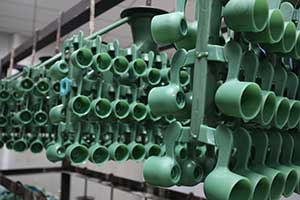
Our skilled technicians begin the faucet manufacturing process by positioning the tree trunk pattern on the workbench. Using specialized electric soldering irons, they meticulously melt and attach each wax pattern connection for premium faucet components. Every joint undergoes rigorous quality checks to prevent welding defects and ensure structural integrity – a standard practice at our China-based foundry. After completing one side, the assembly is carefully flipped (following thorough workspace cleaning with high-pressure air guns) to continue welding operations. This creates a complete wax tree structure, resembling a branched tree, ready for shell making. Our faucet production line maintains strict protocols, with workers using custom hooks to transfer finished assemblies to drying racks before shell workshop processing.
For complex faucet designs featuring blind holes or intricate geometries, our foundry applies advanced manufacturing techniques. The wax patterns are strategically segmented into multiple modules to accommodate challenging mold extraction requirements. As a professional faucet supplier, our tree assembly workshop specializes in precisely welding these modular components, ensuring seamless integration for superior end products. This technical capability allows Chongqing Sipx Machinery to service clients requiring specialized faucet solutions while maintaining our reputation as a reliable China manufacturer for both standard and custom casting applications.
Sand Shell making in our Faucet Foundry
At Chongqing Sipx Machinery, our China-based faucet foundry follows meticulous shell-making procedures. After wax pattern tree assembly, technicians carefully transfer the structures to mobile drying racks (equipped with wheels for seamless workshop transition). The shell-making process begins with thorough water cleaning to remove residual wax particles – a critical quality control step in faucet manufacturing. Our workers then immerse the patterns in premium zirconium slurry tanks, applying specialized techniques to ensure uniform coating adhesion. The zirconium powder’s exceptional fluidity and binding properties significantly enhance mold shell strength, with each dip precisely timed to 60 seconds. Following this, we apply 200-mesh mullite sand coating in our dedicated sand wrapping stations, maintaining consistent thickness before returning the assemblies to drying racks.
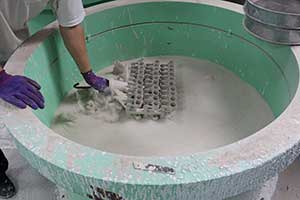 As a professional faucet manufacturer, we employ controlled drying environments with 24/7 climate regulation (28°C at 60% humidity) using multi-directional airflow systems. After 24-hour curing, we repeat the slurry-sand-drying cycle, progressively adjusting sand coarseness from 200 to 16-20 mesh across six layers – a technical approach that ensures both superior surface finish and structural integrity for faucet castings. This graduated sand application method creates optimal mold cavity surfaces while building necessary shell strength. For larger faucet components requiring expanded mold cavities, our foundry specialists increase shell thickness proportionally to withstand molten metal pressures, preventing potential shell fractures during pouring. These refined processes demonstrate why Chongqing Sipx Machinery remains a trusted supplier for precision faucet production worldwide.
As a professional faucet manufacturer, we employ controlled drying environments with 24/7 climate regulation (28°C at 60% humidity) using multi-directional airflow systems. After 24-hour curing, we repeat the slurry-sand-drying cycle, progressively adjusting sand coarseness from 200 to 16-20 mesh across six layers – a technical approach that ensures both superior surface finish and structural integrity for faucet castings. This graduated sand application method creates optimal mold cavity surfaces while building necessary shell strength. For larger faucet components requiring expanded mold cavities, our foundry specialists increase shell thickness proportionally to withstand molten metal pressures, preventing potential shell fractures during pouring. These refined processes demonstrate why Chongqing Sipx Machinery remains a trusted supplier for precision faucet production worldwide.
Wax Removal in our Faucet Foundry
In the heart of our faucet foundry process, the meticulous task of dewaxing plays a crucial role in shaping high-quality water faucet components. Our skilled workers carefully remove the sand molds from the drying racks, unfasten the bolt hooks, and invert them on specialized flat frames designed for wax removal. Once a flatbed truck is fully loaded with these molds, it is maneuvered into the wax removal workshop, where a large, dedicated heating wax removal machine awaits, specifically engineered for this critical step in creating precision water faucet parts.
Our flatbed trucks are designed to hold up to 30 sand molds at a time, with the flexibility to separate them vertically. This allows the upper portion to smoothly slide into the wax removal chamber via the rail system. The chamber itself resembles the return capsule of a manned space flight, a unique and efficient design that enhances the dewaxing process for faucet components.
When the sand shell mold tree containing wax patterns is positioned inside the chamber, the air gate of the wax removal machine is sealed. The inlet valve is closed, and the exhaust valve is opened. Upon activating the machine, it begins to heat and vent, gradually increasing the temperature within the chamber. We set the temperature to 175°C, allowing the machine to reach this level in approximately 8-10 minutes. Once the temperature is achieved, the air inlet valve is opened, and the wax is drained through the outlet below. The molten wax then passes through a filter screen before entering a wax recovery machine for dehydration and degreasing, ensuring the wax can be efficiently recovered and reused in our foundry operations.
After about 15 minutes, the dewaxing process is complete. The master worker opens the air lock door and uses a long iron hook to pull
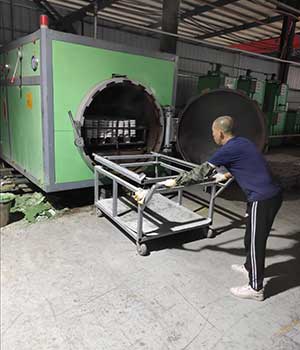
the flatbed truck out. The truck is then guided back along the track and pushed into the cooling workshop, where the molds are allowed to cool, a key step in preparing them for the next stage in the faucet production process.
During the dewaxing process, the nut connecting the base of the wax pattern tree and the hook may fall onto the flatbed truck. Workers
then turn the sand shell upside down, retrieve the nut, and send it back to the wax pattern-making workshop for the creation of new wax patterns. The inner wall of the sand shell, post-dewaxing, feels smooth and shiny to the touch, thanks to the molten wax that once flowed through it.
However, due to the movement and heating involved in the dewaxing process, minor damage to the sand shell is not uncommon. In cases where only one mold shell is damaged, the workers often manage to seal it before proceeding to the next step. But if the damage is extensive, the entire sand mold tree may need to be discarded. Therefore, our workers are trained to handle the molds with utmost care, ensuring minimal damage and maintaining the high standards expected in our foundry operations.
At Chongqing Sipx Machinery, we pride ourselves on delivering exceptional service and being a reliable manufacturer and supplier of high-quality faucet components. Our state-of-the-art foundry processes, combined with our dedication to craftsmanship, ensure that every product we deliver meets the highest standards. Whether you are sourcing from China or anywhere in the world, you can trust us for your faucet foundry needs.
Faucet foundry casting process-Pottery
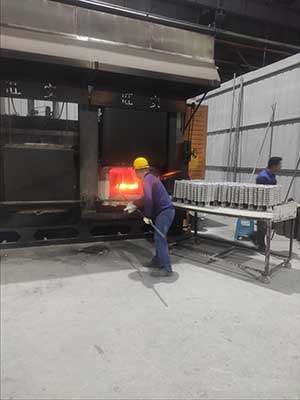
At Chongqing Sipx Machinery, a leading faucet foundry manufacturer and supplier in China, we are dedicated to providing premium water faucet components through our meticulous casting processes. After the sand shell mold tree, or “Fan,” successfully passes through the wax removal process, it is left to cool and dry for over 24 hours. Once the cooling period is complete, our skilled workers carefully place the treated sand mold tree into a flatbed cart and transport it to our specialized pottery workshop, setting the stage for the next critical step in faucet casting.
The pottery process serves two vital purposes. First, it enhances the strength of the sand shell, ensuring the mold shell remains intact during casting and preventing cracks when molten iron is poured in. Second, it ensures the mold shell’s temperature is equalized with the liquid metal’s temperature. This prevents the liquid metal from instantly cooling upon contact with a cold mold shell, which could lead to issues like insufficient liquidity, incomplete pouring, shrinkage, and other defects. Thus, the pottery process is closely integrated with the casting process, ensuring the quality of our water faucet components.
Our workers skillfully utilize a specialized iron fork, approximately 4.5 meters long and shaped like a harpoon, to handle the sand mold. This fork is designed to securely hold the sand mold as it is carefully positioned into the chamber of the pottery furnace. Given the high temperatures within the heating furnace, which can exceed 500 degrees Celsius and sometimes reach thousands of degrees, our workers wear thick insulating gloves and additional protective layers of insulating cotton while gripping the iron fork’s handle. Despite the workers’ rapid and precise movements, it takes about 5 seconds to accurately place the sand mold into position.
The temperature of the iron fork rises significantly during this process. Each sand mold typically weighs between 5 to 10 kilograms, presenting a challenge in handling such a heavy object with a long iron fork. To ensure stability and prevent the mold from falling and breaking, we have implemented a thoughtful mechanism. In front of the heating furnace’s entrance, a shaft is positioned. By leveraging the principle of a lever, the long iron fork is placed on this rotating shaft and fed into the furnace to accommodate the mold shell. The same shaft is utilized when extracting the mold from the furnace, demonstrating our commitment to efficiency and precision in every step of our foundry service. At Chongqing Sipx Machinery, we continue to perfect our processes to deliver exceptional quality in faucet casting.
Casting in Faucet Foundry
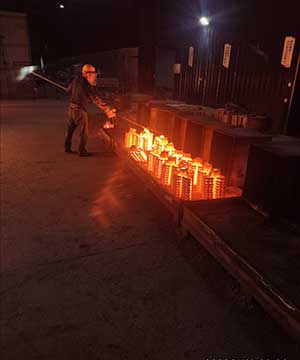
While baking and pottery the sand shell for water faucet components, our experienced workers and master craftsmen at Chongqing Sipx Machinery also commence the furnace operation to melt the metal raw materials.
The initial step involves meticulously cleaning the furnace, a crucial process in our foundry services. The furnace, typically utilizing electromagnetic heating with a common capacity of around 200kg and a height shorter than an average person, features a thick, robust furnace wall. The furnace mouth has a stepped design, sinking about 4cm inward. If it’s the first pouring of the day, the furnace is cool, requiring thorough cleaning of the furnace mouth and wall. Our skilled workers carefully remove residues using a chisel and hammer, followed by high-pressure air gun blowing. Subsequently, the stepped area of the furnace mouth is filled with a cushion-like mixture of mullite and zirconium powder, creating a runner to facilitate the pouring of molten liquid metal for faucet production.
Workers gradually heat some raw materials and slowly warm up the furnace at low power. This low-power heating, often around 500 kilowatts, is vital as workers slowly add raw materials while incrementally increasing the furnace power. It takes approximately one hour to reach high power, operating at about 3500 kW. At this stage, the added raw materials melt visibly. Once the liquid metal is fully melted, due to the high density of metal and low density of impurities, black impurities can be seen floating on the surface of the liquid metal.
The master craftsman then uses a large iron spoon to add a specialized slag remover, resembling sand, into the furnace to eliminate impurities. The slag remover floats above the liquid metal, absorbing impurities. Quickly, the iron bar is turned over and placed into the adjacent waste bucket. Initially, the waste residue appears bright red with a hint of black, then rapidly turns blackish-purple. Depending on the impurity level, the slag removal process is repeated several to over twenty times. The master worker initially assesses based on experience and then sends samples to the laboratory for composition analysis. If any element fails to meet the required standards, corresponding elements are added to ensure the material quality for faucet components.
When the sand shell for water faucet casting is fully baked, the molten liquid metal is correspondingly prepared. Workers, dressed in protective clothing, eye protection helmets, thick thermal insulation gloves, and thermal insulation cotton, open the heating furnace. Using the long iron fork previously used for feeding into the mold, they carefully extract the red-hot mold from the furnace and quickly place it at the furnace guide port. The furnace operator then tilts the furnace, allowing the liquid metal to flow into the mold’s pouring port. Once the mold is completely filled, the furnace is reversed back. Workers holding the molds place the bright red molds onto a platform paved with fine sand in advance. They continue to remove molds from the baking oven and repeat the process. The scene is intense, grand, and fast-paced, evoking a sense of excitement. Each cycle of mold removal, pouring, and placement must be completed within 10 seconds.
At Chongqing Sipx Machinery, as a leading faucet foundry manufacturer and supplier in China, we are committed to delivering exceptional service and high-quality faucet components. Our advanced foundry processes and dedicated craftsmanship ensure that every product meets the highest standards, making us a reliable choice for your faucet casting needs.
Casting Shell Removal
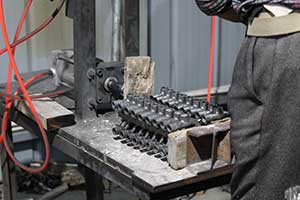 At Chongqing Sipx Machinery, we understand the importance of precision and efficiency in every step of the faucet foundry process. After the fully cooled casted water faucet products are ready, they are carefully transported to our advanced shelling workshop. In ancient times, this process was completed manually through beating, which was not only inefficient and labor-intensive but also time-consuming. However, with our commitment to innovation and quality service, we have embraced modern technology to enhance this critical step.
At Chongqing Sipx Machinery, we understand the importance of precision and efficiency in every step of the faucet foundry process. After the fully cooled casted water faucet products are ready, they are carefully transported to our advanced shelling workshop. In ancient times, this process was completed manually through beating, which was not only inefficient and labor-intensive but also time-consuming. However, with our commitment to innovation and quality service, we have embraced modern technology to enhance this critical step.
Today, our workshop is equipped with specialized vibration shellers designed to efficiently remove the sand shell from the metal. The process begins by placing the product on the designated table, where it is securely fixed before initiating the high-frequency vibration. This state-of-the-art equipment ensures that the sand shell is separated from the metal with minimal effort. Despite the advantages of professional machinery, this task remains physically demanding. Our diligent workers manually move the product trees with mold shells and place them into carts after the shell is removed. During this process, they also carefully select and set aside any obviously substandard pieces. Additionally, the waste slag generated during shelling is thoroughly cleaned to maintain a high standard of cleanliness in our foundry.
The high-frequency vibration and impact produce substantial noise, while the sand shell separation generates a considerable amount of dust. To protect the health of our workers, our workshop is equipped with advanced dust removal systems. We also ensure that all workers wear protective masks and earmuffs to safeguard their well-being. As a responsible manufacturer and supplier of water faucet components in China, we prioritize both product quality and employee safety.
Once the sand shell is successfully removed, the workers transfer the tree-shaped products to the next workshop. Here, the individual water faucet components are carefully separated from the flow channel, marking another meticulous step in our manufacturing process. At Chongqing Sipx Machinery, we continue to push the boundaries of excellence in faucet casting, ensuring that each product meets the highest standards of quality and precision.
How do we Separate the casting parts in our Casting
You will find that every time you search the process flow of investment casting casting faucet on the Internet, most of the procedures after casting are cleaned up, or the post-processing and that is all. Some write that shell shakeout is followed by inspection after cleaning and then warehousing in a casting faucet foundry. But the fact is far more than that in our faucet foundry.
When the cast products come out of the shakeout workshop in our casting faucet foundry, the workers will transfer them into the separation workshop. In order to let the flowing liquid metal enter the product mold cavity smoothly, we must provide it with a forward passage, which is what we call the runner. Do you still remember the tree trunk (mold head) that needs to be made for tree formation when making wax molds? After wax removal, a runner is formed in the die head. Because the wax pattern and die head of the product are welded tightly during tree assembly.
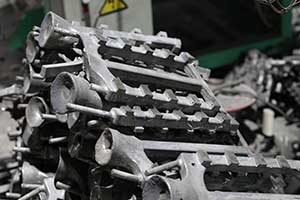 As required, there should be no gaps, otherwise the formation of the flow passage will be affected and the liquid metal will not flow into the product cavity normally. Therefore, after casting and cooling, the runner is a metal block just like the product and is closely connected with the product. It looks like a metal product tree. At this time, we need to separate the product from the metal runner. According to the shape and size of the product, the size of the product casting runner is different. The more complex the product is, the larger the runner is needed to make the liquid metal flow smoothly into the product cavity. At this time, the thicker the connection between the product and the central trunk, the more difficult it is to separate.
As required, there should be no gaps, otherwise the formation of the flow passage will be affected and the liquid metal will not flow into the product cavity normally. Therefore, after casting and cooling, the runner is a metal block just like the product and is closely connected with the product. It looks like a metal product tree. At this time, we need to separate the product from the metal runner. According to the shape and size of the product, the size of the product casting runner is different. The more complex the product is, the larger the runner is needed to make the liquid metal flow smoothly into the product cavity. At this time, the thicker the connection between the product and the central trunk, the more difficult it is to separate.
According to the thickness and direction of the connection, we will use different methods and equipment to separate products. For example, the gap between the product and the central trunk is relatively large, the metal flow channel is thick, and the connection is relatively firm. At this time, the cutting machine can be used for cutting. Place the product tree on the cutting machine workbench, and operate the cutting machine to separate the product from the die head after fixing. At this time, the scene can be compared to a beautiful fireworks, sparks splashed, and loud noise. And accompanied by the unpleasant smell of metal burning diffusion. The operator needs to be very careful to prevent injury. At the same time, it is also necessary to wear protective masks, helmets, ear protectors, etc. to protect the respiratory tract, vision and hearing.
If the product connection channel does not need to be too large, then we will make the connection smaller. In this way, the product tree can be fixed on a special fixed lathe, and then the workers use a specially designed crowbar to pry the product using the principle of lever and metal fatigue. Separate the product from the die head. It is relatively easy, but the labor operation cost is also high and the speed is slow.
When separating the products, the casting faucet foundry workers will put the qualified products into the basket specially filled with qualified products. The defective products produced after casting cooling do not need to be separated and put into the waste blue for recycling.
The separated finished product will retain the flash at the separation point, which is usually large. Some reach more than 5mm. Therefore, we will send them to the rough grinding workshop in our casting faucet foundry for polishing.
Rough Grinding casting faucet part
When the casting faucet part is separated from the die head (runner), large burrs and flash will remain at their joints. The workers sent them to the grinding workshop. There are grinding machines roaring here. The workers hold the casting faucet parts and grind and remove the casting faucet part burrs one by one.
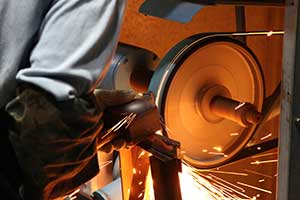 The grinder we use here is different from the ordinary fixed grinding wheel. Due to the large amount of grinding, the wear is quite serious. Therefore, replaceable sand belt is adopted. The sand belt is covered with high-strength grinding sand grains. Fix the grinding belt on the belt pulley to form the grinding wheel. When the grinding wheel rotates, the workers will slowly approach the bulge and flash formed by the cutting edge. Carefully grind off the bulges and fins.
The grinder we use here is different from the ordinary fixed grinding wheel. Due to the large amount of grinding, the wear is quite serious. Therefore, replaceable sand belt is adopted. The sand belt is covered with high-strength grinding sand grains. Fix the grinding belt on the belt pulley to form the grinding wheel. When the grinding wheel rotates, the workers will slowly approach the bulge and flash formed by the cutting edge. Carefully grind off the bulges and fins.
During operation, workers can judge whether it is completely removed or excessively polished by visual inspection and experience. Therefore, the operation also needs to be bold and careful. Unqualified casting faucet parts or parts with excessive grinding will be put into the waste box for scrapping.
The polished casting faucet parts will be sent to the shot blasting workshop for sand removal.
Sand cleaning process
Remove the bulges and big flash burrs connected with the die head by workers’ first polishing. The products will be sent to the shot blasting workshop. The product just cast is black gray. Every nook and cranny is covered with residual mold sand. Especially for products with inner holes or blind holes. It can not be removed cleanly by vibration or manual shelling.
Shot blasting machine is used to remove sand and oxide skin on the surface of cast steel and iron castings in the casting industry.
Almost all steel castings, grey castings, malleable iron castings and ductile iron castings shall be shot blasted. This is not only to remove the oxide skin and sand on the casting surface, but also an indispensable preparation process before the casting quality inspection. In general casting production, shot blasting is an indispensable process to find surface defects of castings, such as subcutaneous blowholes, slag holes, sand sticking, cold shut, peeling, etc. The shot blasting machine used for precision casting products is generally drum type and chain plate type. Drum type and chain plate type shot blasting machines are suitable for cleaning small and medium-sized castings that are not afraid of collision. The drum type shot blasting machine makes the casting overturn and move forward by relying on the spiral guide bars in the barrel.
The chain plate shot blasting machine makes the casting overturn and run through the movement of the chain plate. Rotary table, trolley type and hanging type shot blasting machines are used to clean large and medium-sized castings. Usually, they are equipped with fixed shot blasting chambers in which the cleaned castings rotate or move. The shot blasting room is generally equipped with several shot blasting machines, which are installed at different positions and shot from different directions to improve the cleaning efficiency and quality of the shot blasting machine. The hanging shot blasting machine can be equipped with several hooks on the catenary according to the needs of the castings to be cleaned. During cleaning, the castings are hung on the hooks and turn over automatically while moving forward. Castings shall be loaded and unloaded outside the shot blasting room and cleaned indoors.
The shot blasting machine is mainly composed of four parts: ① The shot blasting machine generally uses high-speed rotating impeller to shoot the shot in a certain direction under the action of high centrifugal force. During operation, some shot blasting machines can swing at a certain angle or move up and down. ② Pill collection, separation and transportation system. ③ The bearing body that makes the casting continuously run and overturn during shot blasting cleaning. ④ Dust removal system.
Shot blasting process can not only remove large area of bonded sand, but also remove the burrs of castings. At the same time, defective products can be found after removing the oxide skin on the casting surface. The shot blasting time varies according to the product. But it is impossible to remove the stubborn sticky sand by shot blasting alone. Moreover, shot blasting shall not be carried out for unlimited times and time. Because excessive shot blasting will damage the product itself.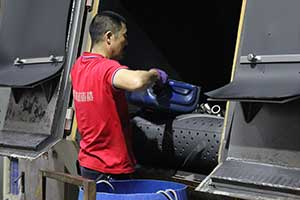
A second program needs to be introduced. After a shot blasting, put the product into a plastic bucket. Transfer the product into the pickling workshop. The pickling workshop must be equipped with a full set of sewage treatment system. This sewage treatment system occupies more than half of the whole workshop. The plastic buckets filled with products are filled with water holes, and these buckets are put into the pool where the pickling solution is prepared. The acid will flow into the barrel through the small hole to soak the casting. After a certain period of time, lift out the plastic bucket, drain it, and then put it into the clear water tank for clear drainage. After being drained again, the workers will transport them to the shot blasting workshop again for shot blasting and sand removal. Repeat until the sand is completely removed. Determined by visual inspection.
For those products that are difficult to remove, we also need to remove them manually. High pressure sand blasting equipment is required. Finally, completely clean the casting. The cleaned product looks smooth and clean. However, there are still some surface burrs in corners that cannot be removed by large area shot blasting. Therefore, the products need to be sent to the fine grinding workshop.
Faucet parts producing process in faucet casting foundry-Fine Grinding
After rough grinding, pickling and shot blasting, the faucet components’ surface has been very smooth. However, a large area of shot blasting cannot remove burrs and fins in some corners. In addition, product damage may occur in previous processes.  Therefore, it is necessary to transfer the products to the fine grinding workshop.
Therefore, it is necessary to transfer the products to the fine grinding workshop.
Here, the workers will use a small hand grinder to smooth the fine burrs on the product surface, and further remove the traces of the die head connection. In addition, the workers in this workshop are also responsible for selecting defective products. The surface of precision casting products polished by hand grinder is as smooth as a mirror, shining bright and very beautiful. This is also the last link of the product. After careful polishing, the products will enter the quality inspection and packaging workshop for final inspection and packaging.
Types of materials used for Faucet casting
|
Materials |
Detail |
|
Brass |
Brass is the most common material used for faucet casting due to its durability, corrosion resistance, and ease of casting. |
|
Stainless steel is a durable, long-lasting material that is resistant to corrosion and rust. |
|
|
Bronze |
Bronze is an alloy of copper and tin that is heavier and more expensive than brass but has superior corrosion resistance and aesthetic appeal. |
|
Zinc |
Zinc is a popular material for casting cheaper faucets since it is easy to cast, but it is less durable than brass. |
Post processes for faucet casting
Faucet casting is a common process used to manufacture faucets for plumbing applications. Here are some post processes that are typically involved in the faucet foundry casting process:
It is important to note that the specific post-casting processes may vary depending on the manufacturer, design requirements, and materials used for the faucet casting.
FAQs about our Faucet Casting Foundry

A faucet foundry is a facility or factory where the process of casting faucets takes place. It involves melting and pouring molten metal into molds to create faucet components.
The most commonly used metals for faucet casting are brass, stainless steel, and zinc alloys. Brass is preferred for its corrosion resistance and aesthetic appeal, while stainless steel offers durability and a modern look. Zinc alloys are often used for cost-effective production.
The casting process typically involves creating a mold of the desired faucet component, melting the chosen metal, and pouring it into the mold. Once the metal solidifies, the mold is removed, and post-casting processes are performed to finish and assemble the faucet.
Faucet casting offers several advantages, such as the ability to create complex shapes and intricate designs, cost-effectiveness in large-scale production, and the ability to customize faucets according to specific requirements.
Yes, there are environmental considerations associated with faucet casting. The process involves the use of energy to melt metals, and the disposal of waste materials such as sand, mold coatings, and excess metal. Responsible foundries implement measures to reduce energy consumption, recycle materials whenever possible, and properly manage waste disposal.
Yes, faucet casting can produce various types of faucets, including single-handle faucets, double-handle faucets, wall-mounted faucets, and more. The versatility of the casting process allows for the creation of different faucet styles and configurations.
Quality control measures during faucet casting may include inspecting the molds for defects, monitoring the metal composition and temperature, conducting dimensional checks on the cast components, and performing pressure and functional testing on finished faucets.
The time required for faucet casting can vary depending on factors such as the complexity of the design, the type of metal used, and the production capacity of the foundry. It can range from a few hours to several days or more, considering the various stages involved in the process.
The Mini batch quantity usually based on the single weight of the faucet part. Our smallest melt oven loads 800kgs to 1000kgs of metal. Min order batch is for one oven. Of cause, if you can share the extra cost, there is no MOQ limit.
Just send your drawing or samples for a detail quotation. If you do not have those info, please feel free to send us mail to get suggestion. Thank you.

At SipxMach, our goal is to help our customers lower production costs and increase production rates and quality. Interested to see what SipxMach can do for you and your team? Contact us to schedule a tour of our state-of-the-art facility
- Contact: Rubio
- Email: [email protected]
- Microsoft Teams: Rubioli8677 (Sales manager)
- Office Add: No.551, Baosheng Avenue, Huixing Street, Yubei District, Chongqing, China
- Foundry Add: No. 4 Jindi Avenue, Dongcheng Street, Tongliang District, Chongqing

